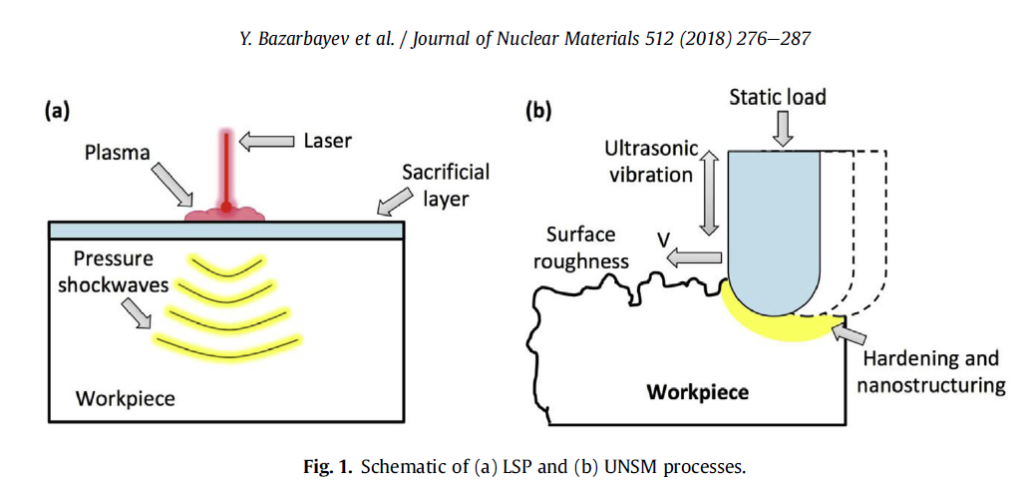Laser Peening fights radiation-based PWSCC in nickel alloy
Laser peening fights metal fatigue in nuclear components
Posted: November 12, 2018
By:
Research team includes Micheal Kattoura, now an LSPT materials scientist
Laser peening can prevent or arrest failure of pipes and containment structures due to one of the most pernicious metal threats to nuclear components: Primary Water Stress Corrosion Cracking (PWSCC). That is the conclusion of a team of scientists from Purdue, the University of Cincinnati (UC) and Idaho National Laboratory, including Micheal Kattoura, then a Ph.D. candidate at UC and now a Materials Scientist at LSP Technologies, Inc. (LSPT).
Kattoura worked with an interdisciplinary team to publish their findings in the Journal of Nuclear Materials as “Effects of corrosion-inhibiting surface treatments on irradiated microstructure development in Ni-base alloy 718,” published online in early October (See abstract or access the full study at https://www.sciencedirect.com/science/article/pii/S0022311518309097 – download fees apply).

“Radiation looks for ways to attack the structural integrity of metal parts, especially areas at or near the surface of the part,” Kattoura said.
“We call these point defects, and – depending on the type of metal – the radiation will make parts more brittle, softer or more vulnerable to corrosion and cracking. But by all the measures that we used in the experiments, laser peening provided substantial benefits to prevent damage to irradiated parts.”
The newly published research, though not sponsored by LSPT, adds to the strong rationale for providing laser peening equipment to the nuclear power industry , said David Lahrman, LSP Technologies VP of Business Development. (See LSP Technologies Wins Customers in New Markets.) “We’ve been supplying laser peening services to the power generation industry for many years, and this research is another indication of how much nuclear power operations can benefit from laser peening,” he said.
Co-authors of the study on LSP and UNSM corrosion-inhibiting treatments:
Yerik Bazarbayev, Purdue School of Nuclear Engineering, principal writer/author
Micheal Kattoura, Department of Mechanical & Materials Engineering, University of Cincinnati (now at LSP Technologies, Inc.)
Keyou S. Mao, School of Materials Engineering, Purdue University, and the Materials and Fuels Complex, Idaho National Laboratory, Idaho Falls.
Jie Song, Department of Mechanical & Materials Engineering, University of Cincinnati
Vijay K. Vasudevan Department of Mechanical & Materials Engineering, University of Cincinnati
Janelle P. Wharry, Purdue School of Nuclear Engineering
High temperature to simulate PWSCC-causing radiation
“The collaborative work on this project documents the benefits of the laser peening process in mitigating radiation damage that leads to PWSCC,” Kattoura said. “We laser peened samples and then subjected them to radiation, raising the temperature to 500° +/- C to simulate long-term conditions in nuclear reactors.”
The researchers then compared the effects of irradiation on the baseline untreated alloy, the laser peened alloy and the alloy treated with ultrasonic nanocrystal surface modification (UNSM). The nickel alloy was less susceptible to metal softening and metal irradiation damage, such as point defects and voids, thanks to laser peening, Kattoura said.
“We had a well-defined focus and a highly organized sequence of hand-offs at the beginning of the research. We used laser peening and UNSM to treat the nickel-based material at the University of Cincinnati, and then we sent our material samples to the Idaho National Laboratory for the radiation simulation. Then the material went to Purdue for analysis, and then ultimately back for more analysis in Cincinnati, which really isn’t that far from Purdue,” Kattoura said.
Samples were laser peened at UC using a neodymium-doped yttrium aluminum garnet (Nd:YAG) laser at 3 joules. The nickel alloy was also treated with UNSM at UC.
“We found that both laser peening and UNSM can help protect the metal against PWSCC. LSP does it through the deformation and plasticity of the metal due to the laser-induced shock wave. UNSM uses ultrasonic vibrations in addition to an applied static load on the material surface,” Kattoura said.

“Laser peening creates the highest density of dislocation in the metal, and those dislocations increase the sink strength to prevent radiation effects like PWSCC,” he said.
What is sink strength? Grain boundaries, dislocations and other microstructural features can act as sinks for point defects caused by radiation, an ability measured as sink strength. Laser peening will not only help prevent PWSCC, but also other types of damage from radiation, the researchers found:
• Prevention of corrosion and cracking due to laser peening-induced compressive residual stress.
• Prevention of point defects or voids in the metal structure due to higher sink strength.
• Prevention of precipitation disordering from radiation and increasing the dislocation density.
Interested in Seeing More?
Tell us about your application, material, or failure mechanism and we will have one of our experts reach out to you. Our extensive library of research and years of experience gives us a unique advantage to apply a finite element analysis to help diagnose the best application for your situation.
